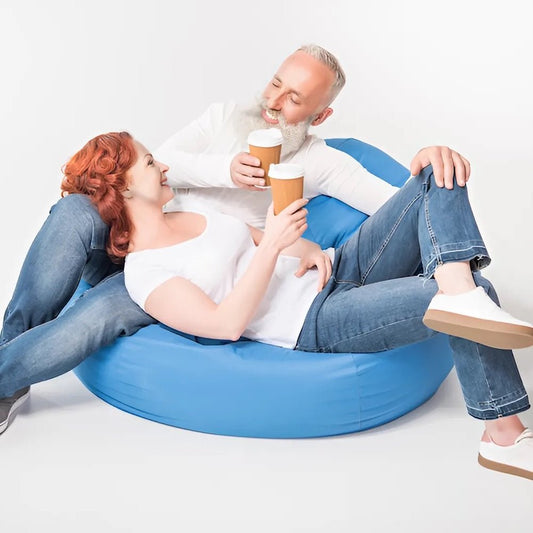It seems like your dog is destined to be by your side twenty-four seven. Even after you fall asleep no matter what, you find your pooch cuddled up beside you on the pillow. So how can you train your dog to sleep anywhere else but in your bed? Dogs are social animals. No doubt that yours wants to spend as much time with you as possible. Being with your dog is lovely, but it can present a few difficulties especially when you require a good night's sleep. One of the hardest parts of being a doggie parent is trying to get a good night’s sleep. Especially when you are a light sleeper or require silence and stillness to drift into dreamland. While it may seem impossible at first, you can get your dog to sleep in his or her bed. And you can do it without having to feel sorry about pushing your treasured companion out of yours. However, it can help tremendously in training to buy a dog bed that will keep your pets warm, snug and comfortable.
a dog in the bed
Recently, the APPA National Pet Owners, the UC Davis School of Veterinary Medicine and the U.S. Centers for Disease Control (CDC) conducted surveys. The results show between forty-five per cent, and sixty per cent of pet owners share their beds with their dogs. And these pet owners allow their pets to sleep with them every night. These results come as no surprise because a warm, fluffy dog can make an excellent companion in most situations. Between thirteen per cent and thirty-three per cent of survey respondents believe their dogs help them sleep. However, nearly all the people who share their beds with their dogs admit that they have had their sleep disrupted at least once. And approximately 10 per cent of pet owners surveyed by the Mayo Clinic Center for Sleep Medicine says that sleep disruptions caused by dogs occur much more frequently than that. A different study found that about fifty per cent of pet owners allow dogs in their beds, and thirty per cent of those who do are woken up by them at least once each night. Another survey shows that up to sixty-three per cent of people who let their pets sleep with them for four nights per week or more suffer from poor sleep quality. Also, five per cent of survey respondents reported they have trouble falling back asleep nearly every time their pets wake them. Many people sleep so lightly that their dogs do not even have to be in the same bed. Nearly fifty-eight per cent of pet owners told the Mayo Clinic that they have trouble sleeping when their dogs are merely in the same room. Dogs can scratch, twitch, ruffle their bed, toss and turn and even snore. For some people also sharing a room with their pet may disturb their sleep.
sleep disruptions caused by dogs
Some of the top reasons for sleep disruptions caused by dogs are as follows:
- Snoring
- Whimpering and other sounds
- Getting out of and back into bed in the middle of the night
- Walking around on top of the bed
- Shuffling under the blankets
- Barking
possible causes for dog disturbances
- Thunder and lightning
- Heavy rain and stormy weather
- Other dogs barking
- The need to go to the toilet
- Strange Noises
- Wind
Most of the reasons why your dog likes to sleep with you and why you may be suffering from a lack of sleep is because of your dog can be explained by standard behaviour patterns. Your dog may need to be let out to pee, or he or she may be cold-blooded and prefer to sleep next to you under the blankets to stay warm and cozy. Pomeranians, Chihuahuas, Pugs and Shih Tzus are all notorious for their dislike of the cold and their need to cuddle.
canine sleep disorders
However, the reasons why your dog is disrupting your sleep may not be so apparent. If your dog has to pee frequently during the night, it could be a sign that he or she is suffering from a urinary tract infection (URI). And if your dog gets up and wanders around the bedroom, it could be because of a cognitive dysfunction syndrome (CDS). Once your dog has been declared healthy by a veterinarian, you may come to find that you have inadvertently created this problem by encouraging your dog to sleep with you. Although you do not have to buy luxury dog beds when you first introduce a new dog to your home, you should already be decided on sleeping arrangements to avoid problems down the road. If you believe your sleep will be disrupted, it's best to have your dog sleep in his or her space from the beginning. You may have to start by putting a pet bed in a crate to help understand which bed they should use in the future. If you decide that your dog will sleep in your bed or will have a separate bed in your room, then you should immediately begin to lay out the ground rules. Your dog may want to wake up and play in the middle of the night, and if you allow this to happen more than a few times, it will become a habit that's hard to break. You can take steps to train your dog when and where to sleep. You will be grateful you did so before his or her behaviour becomes disruptive. If your dog wants to play in the middle of the night, you can take him or her outside to burn some energy before bedtime. If he or she gets hungry while you are trying to sleep, you can adjust dinnertime to be a little later in the evening.
training your dog to sleep in a new bed
You may be one of those pet owners whose sleep interruptions are worth the comfort of having your dog in the bed during the night. However, if your psychological or physical health is suffering because of these disturbances in sleep, you should train your dog to sleep in a different bed. Although the steps to accomplishing this goal are not tricky, it could take some time. You will have to be diligent and consistent in your training, and your patience may be tested.
following are a few tricks for getting your dog out of your bed:
- Purchase a quality dog bed, and place it next to your bed. You can buy several luxury dog beds, or you can spruce up the bed with extra pillows and blankets.
- Train your dog to get out of and into the bed on command through standard positive-reinforcement exercises.
- Your dog considers you to be the leader of the pack. He or she will want to sleep close to you. But it is up to you to give the commands to get out of your bed and into his or her bed.
- Your dog may obey your commands while you are awake but try to sneak into your bed after you have fallen asleep. You will have to be patient and persistent during this time until your dog fully understands the situation.
- Teach your dog to go to their bed during the day, enforcing the correct place to sleep through repetition.
- Ensure your dog's bed is inviting. You may need to clean it regularly, so it doesn't harbour foul smells or bugs.
- Consider purchasing a new bed for your pet. How old is their current bed? Would you sleep in it?
- Avoid letting them sit on your bed during the day or before you go to sleep. Habits are easily formed. If your pet thinks it's acceptable to be on your bed, they will not understand why you are telling them to get off when you're trying to sleep.
- Don't move their bed around the house. It's crucial that their bed remains in the same location each night so your baby doesn't get confused about where he or she should be sleeping.
- Make sure your dog has the correct size and shape to suit their sleeping habits. If the bed is too small or too big, it may be causing discomfort or disruption to their sleep. Here are some tips to help you choose the right dog bed for your dog.
- When your dog goes to their own bed, reward them with a treat.
doesn't your best friend deserve a good night's sleep?
If your bed is more comfortable than the dog's, chances are they will prefer to sleep in your bed. Consider investing in a dog bed that your dog loves to use. Dog bean bags are an excellent alternative to foam filled beds because they provide even body support from head to toe. Our range of Ultimate Dog Beds also has the bonus of washable covers and removable fur tops for cold climates. We've received many reviews from happy dog owners who are a testament to the fact that their dog will not sleep on anything else.




